Management Study: Literature Review of Factors Influencing Sales
VerifiedAdded on 2023/04/21
|10
|2268
|425
Literature Review
AI Summary
This literature review explores the various factors that influence the sales performance of a retail organization. It uses academic literature to develop problem-solving models based on theories such as reinforcement learning, learning automata, and partial observability. The review identifies key factors, including customer experiences, artificial intelligence, big data, hyper-personalization, health-conscious customers, augmented and virtual reality, multi-channel retail strategies, digital mobile wallets, quick shipping, the Internet of Things, and sustainability. Additionally, it discusses best practices in manufacturing and operations, such as Statistical Quality Control (SQC), Lean Manufacturing, and Business Process Redesign (BPD), along with relevant research methodologies like the theory of planned behavior, innovation and adoption theory, and elaboration likelihood theory. The review concludes by recommending strategies to improve brand loyalty, marketing practices, and overall sales performance.
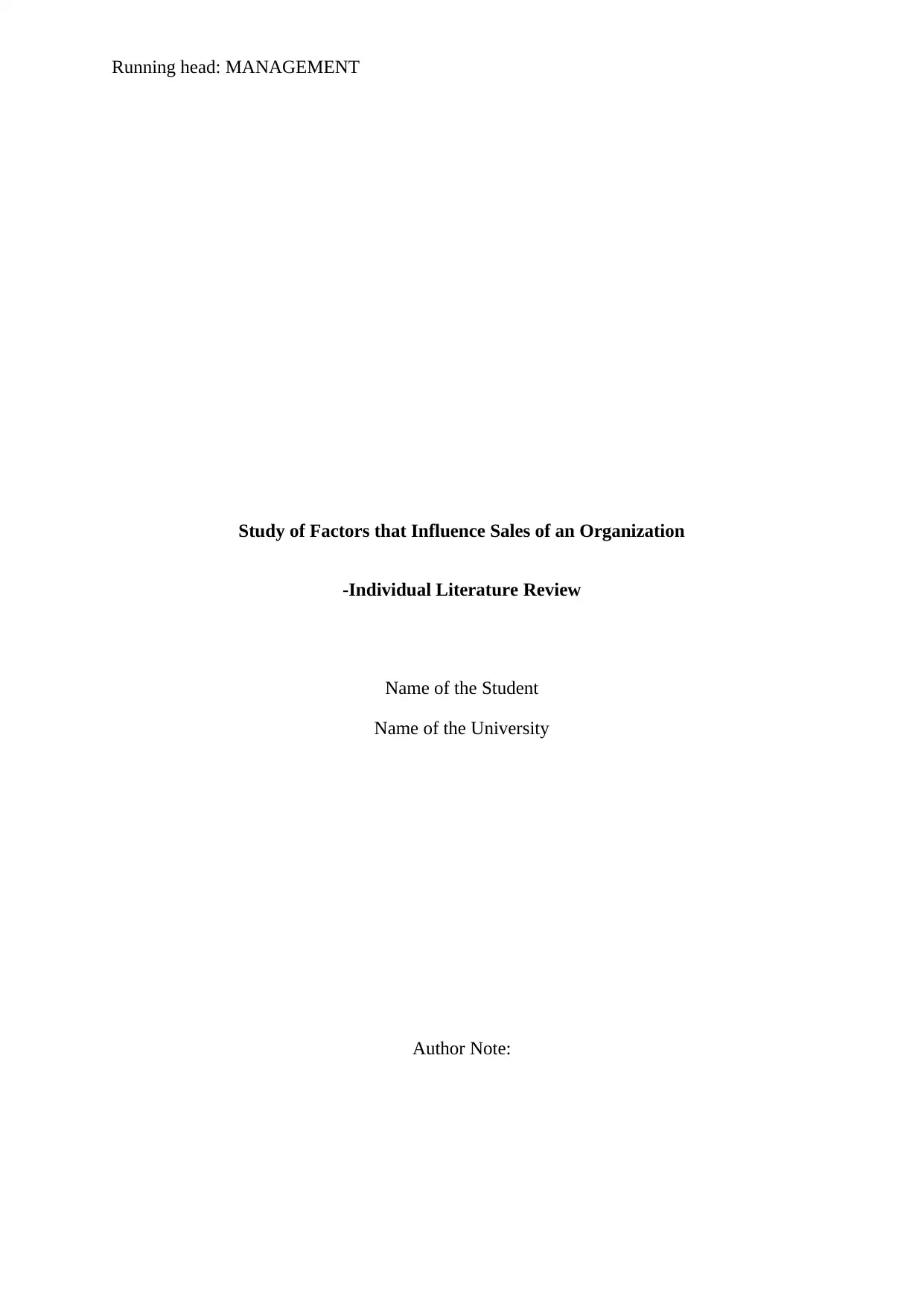
Running head: MANAGEMENT
Study of Factors that Influence Sales of an Organization
-Individual Literature Review
Name of the Student
Name of the University
Author Note:
Study of Factors that Influence Sales of an Organization
-Individual Literature Review
Name of the Student
Name of the University
Author Note:
Paraphrase This Document
Need a fresh take? Get an instant paraphrase of this document with our AI Paraphraser
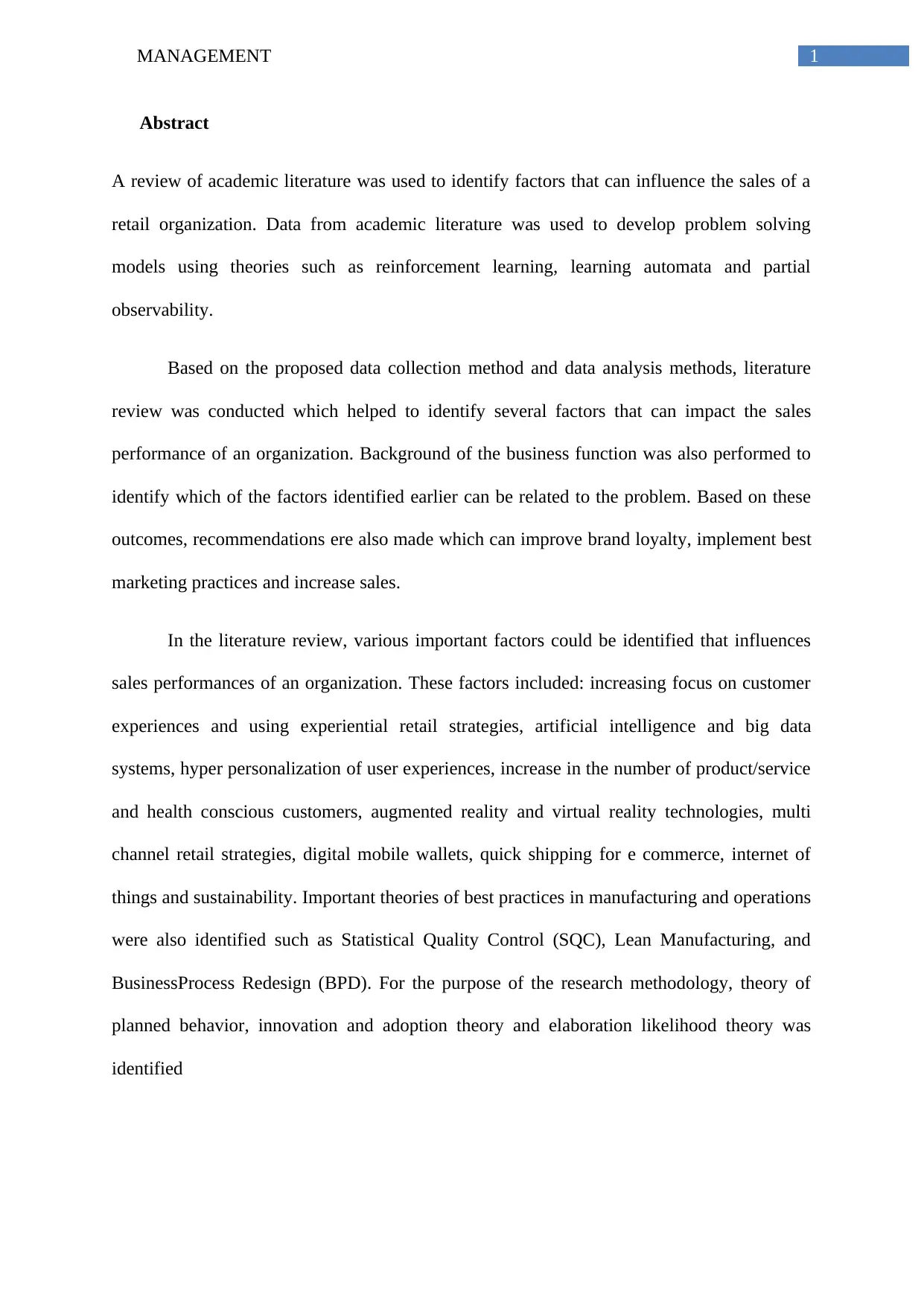
1MANAGEMENT
Abstract
A review of academic literature was used to identify factors that can influence the sales of a
retail organization. Data from academic literature was used to develop problem solving
models using theories such as reinforcement learning, learning automata and partial
observability.
Based on the proposed data collection method and data analysis methods, literature
review was conducted which helped to identify several factors that can impact the sales
performance of an organization. Background of the business function was also performed to
identify which of the factors identified earlier can be related to the problem. Based on these
outcomes, recommendations ere also made which can improve brand loyalty, implement best
marketing practices and increase sales.
In the literature review, various important factors could be identified that influences
sales performances of an organization. These factors included: increasing focus on customer
experiences and using experiential retail strategies, artificial intelligence and big data
systems, hyper personalization of user experiences, increase in the number of product/service
and health conscious customers, augmented reality and virtual reality technologies, multi
channel retail strategies, digital mobile wallets, quick shipping for e commerce, internet of
things and sustainability. Important theories of best practices in manufacturing and operations
were also identified such as Statistical Quality Control (SQC), Lean Manufacturing, and
BusinessProcess Redesign (BPD). For the purpose of the research methodology, theory of
planned behavior, innovation and adoption theory and elaboration likelihood theory was
identified
Abstract
A review of academic literature was used to identify factors that can influence the sales of a
retail organization. Data from academic literature was used to develop problem solving
models using theories such as reinforcement learning, learning automata and partial
observability.
Based on the proposed data collection method and data analysis methods, literature
review was conducted which helped to identify several factors that can impact the sales
performance of an organization. Background of the business function was also performed to
identify which of the factors identified earlier can be related to the problem. Based on these
outcomes, recommendations ere also made which can improve brand loyalty, implement best
marketing practices and increase sales.
In the literature review, various important factors could be identified that influences
sales performances of an organization. These factors included: increasing focus on customer
experiences and using experiential retail strategies, artificial intelligence and big data
systems, hyper personalization of user experiences, increase in the number of product/service
and health conscious customers, augmented reality and virtual reality technologies, multi
channel retail strategies, digital mobile wallets, quick shipping for e commerce, internet of
things and sustainability. Important theories of best practices in manufacturing and operations
were also identified such as Statistical Quality Control (SQC), Lean Manufacturing, and
BusinessProcess Redesign (BPD). For the purpose of the research methodology, theory of
planned behavior, innovation and adoption theory and elaboration likelihood theory was
identified
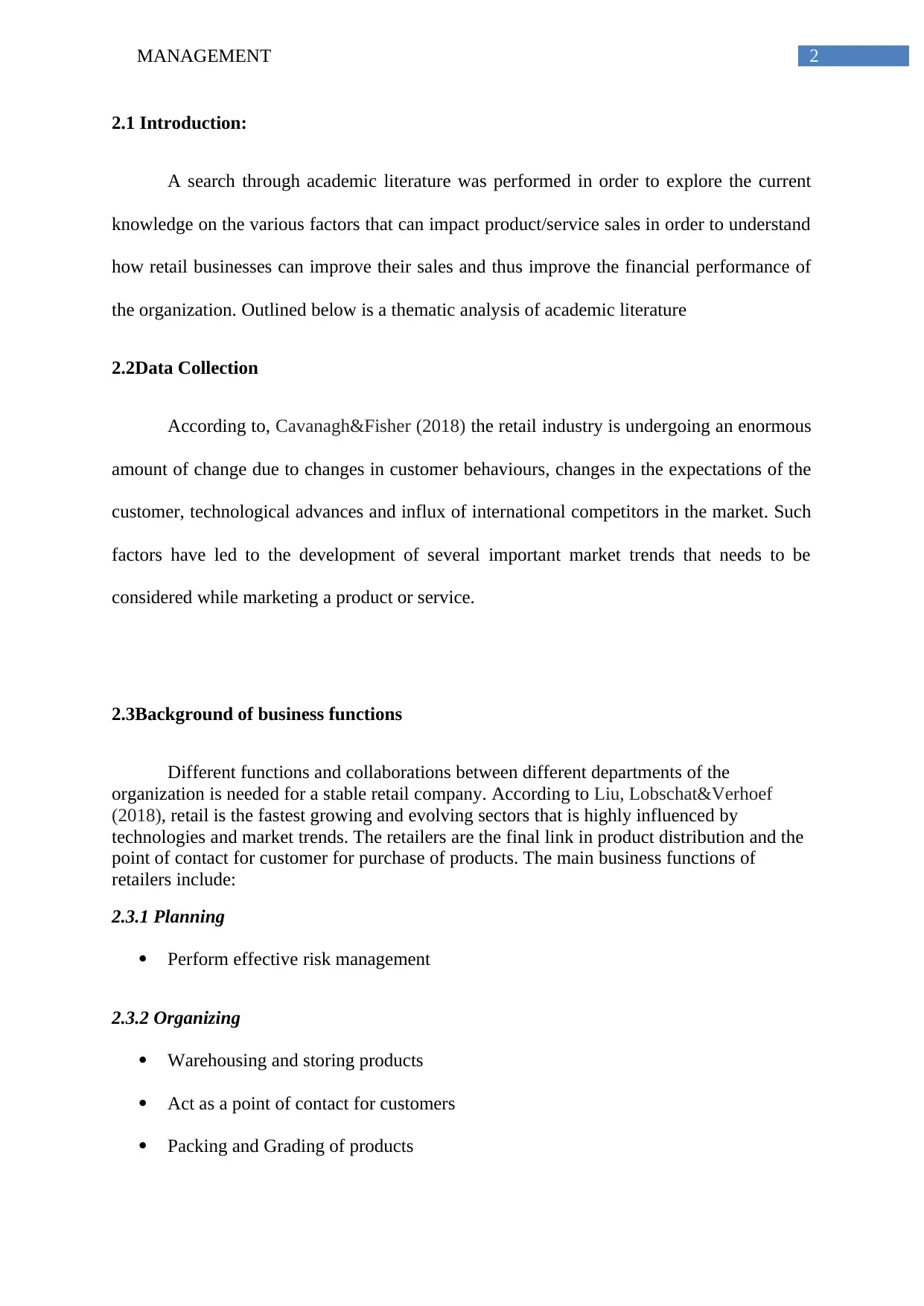
2MANAGEMENT
2.1 Introduction:
A search through academic literature was performed in order to explore the current
knowledge on the various factors that can impact product/service sales in order to understand
how retail businesses can improve their sales and thus improve the financial performance of
the organization. Outlined below is a thematic analysis of academic literature
2.2Data Collection
According to, Cavanagh&Fisher (2018) the retail industry is undergoing an enormous
amount of change due to changes in customer behaviours, changes in the expectations of the
customer, technological advances and influx of international competitors in the market. Such
factors have led to the development of several important market trends that needs to be
considered while marketing a product or service.
2.3Background of business functions
Different functions and collaborations between different departments of the
organization is needed for a stable retail company. According to Liu, Lobschat&Verhoef
(2018), retail is the fastest growing and evolving sectors that is highly influenced by
technologies and market trends. The retailers are the final link in product distribution and the
point of contact for customer for purchase of products. The main business functions of
retailers include:
2.3.1 Planning
Perform effective risk management
2.3.2 Organizing
Warehousing and storing products
Act as a point of contact for customers
Packing and Grading of products
2.1 Introduction:
A search through academic literature was performed in order to explore the current
knowledge on the various factors that can impact product/service sales in order to understand
how retail businesses can improve their sales and thus improve the financial performance of
the organization. Outlined below is a thematic analysis of academic literature
2.2Data Collection
According to, Cavanagh&Fisher (2018) the retail industry is undergoing an enormous
amount of change due to changes in customer behaviours, changes in the expectations of the
customer, technological advances and influx of international competitors in the market. Such
factors have led to the development of several important market trends that needs to be
considered while marketing a product or service.
2.3Background of business functions
Different functions and collaborations between different departments of the
organization is needed for a stable retail company. According to Liu, Lobschat&Verhoef
(2018), retail is the fastest growing and evolving sectors that is highly influenced by
technologies and market trends. The retailers are the final link in product distribution and the
point of contact for customer for purchase of products. The main business functions of
retailers include:
2.3.1 Planning
Perform effective risk management
2.3.2 Organizing
Warehousing and storing products
Act as a point of contact for customers
Packing and Grading of products
⊘ This is a preview!⊘
Do you want full access?
Subscribe today to unlock all pages.

Trusted by 1+ million students worldwide
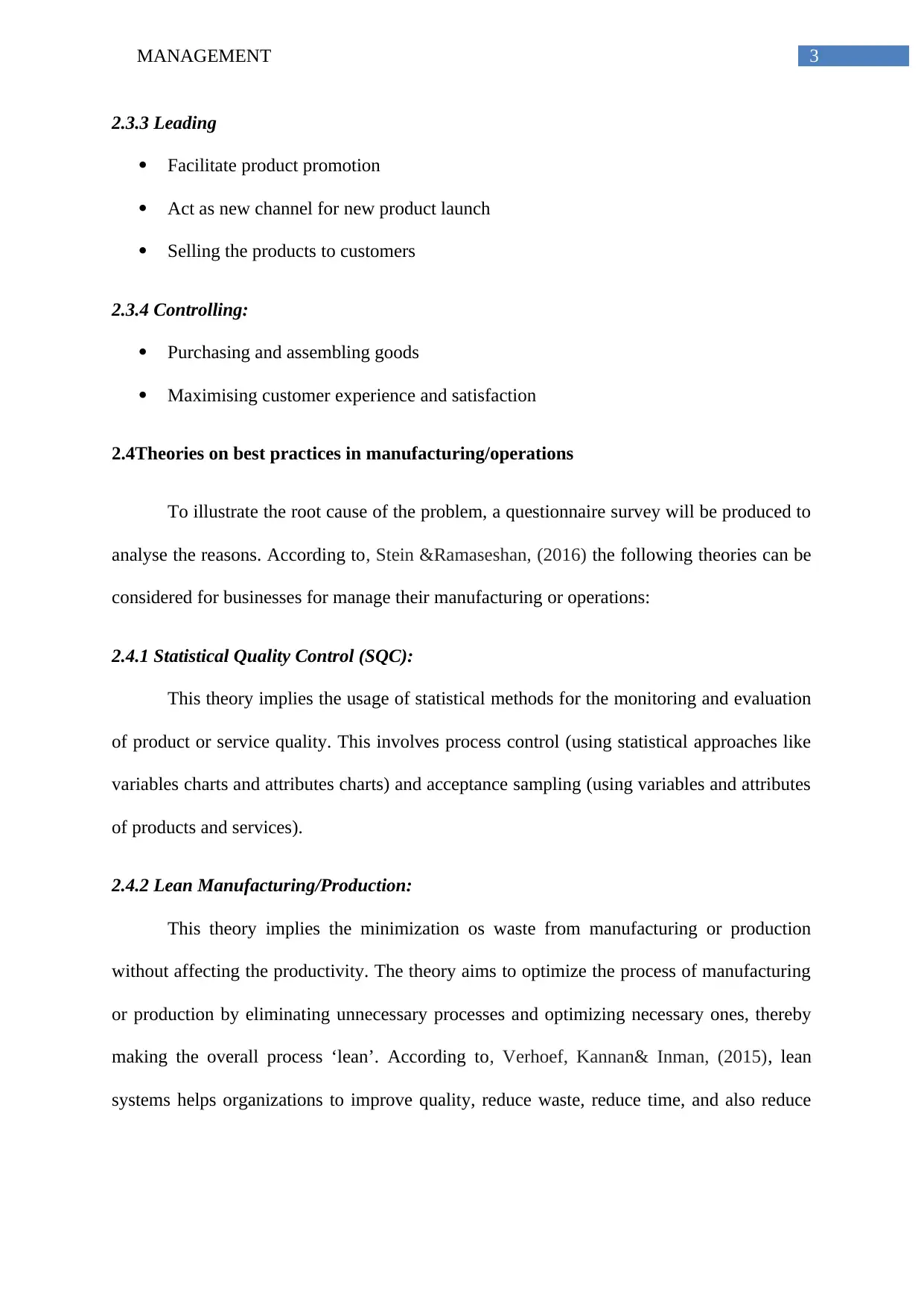
3MANAGEMENT
2.3.3 Leading
Facilitate product promotion
Act as new channel for new product launch
Selling the products to customers
2.3.4 Controlling:
Purchasing and assembling goods
Maximising customer experience and satisfaction
2.4Theories on best practices in manufacturing/operations
To illustrate the root cause of the problem, a questionnaire survey will be produced to
analyse the reasons. According to, Stein &Ramaseshan, (2016) the following theories can be
considered for businesses for manage their manufacturing or operations:
2.4.1 Statistical Quality Control (SQC):
This theory implies the usage of statistical methods for the monitoring and evaluation
of product or service quality. This involves process control (using statistical approaches like
variables charts and attributes charts) and acceptance sampling (using variables and attributes
of products and services).
2.4.2 Lean Manufacturing/Production:
This theory implies the minimization os waste from manufacturing or production
without affecting the productivity. The theory aims to optimize the process of manufacturing
or production by eliminating unnecessary processes and optimizing necessary ones, thereby
making the overall process ‘lean’. According to, Verhoef, Kannan& Inman, (2015), lean
systems helps organizations to improve quality, reduce waste, reduce time, and also reduce
2.3.3 Leading
Facilitate product promotion
Act as new channel for new product launch
Selling the products to customers
2.3.4 Controlling:
Purchasing and assembling goods
Maximising customer experience and satisfaction
2.4Theories on best practices in manufacturing/operations
To illustrate the root cause of the problem, a questionnaire survey will be produced to
analyse the reasons. According to, Stein &Ramaseshan, (2016) the following theories can be
considered for businesses for manage their manufacturing or operations:
2.4.1 Statistical Quality Control (SQC):
This theory implies the usage of statistical methods for the monitoring and evaluation
of product or service quality. This involves process control (using statistical approaches like
variables charts and attributes charts) and acceptance sampling (using variables and attributes
of products and services).
2.4.2 Lean Manufacturing/Production:
This theory implies the minimization os waste from manufacturing or production
without affecting the productivity. The theory aims to optimize the process of manufacturing
or production by eliminating unnecessary processes and optimizing necessary ones, thereby
making the overall process ‘lean’. According to, Verhoef, Kannan& Inman, (2015), lean
systems helps organizations to improve quality, reduce waste, reduce time, and also reduce
Paraphrase This Document
Need a fresh take? Get an instant paraphrase of this document with our AI Paraphraser
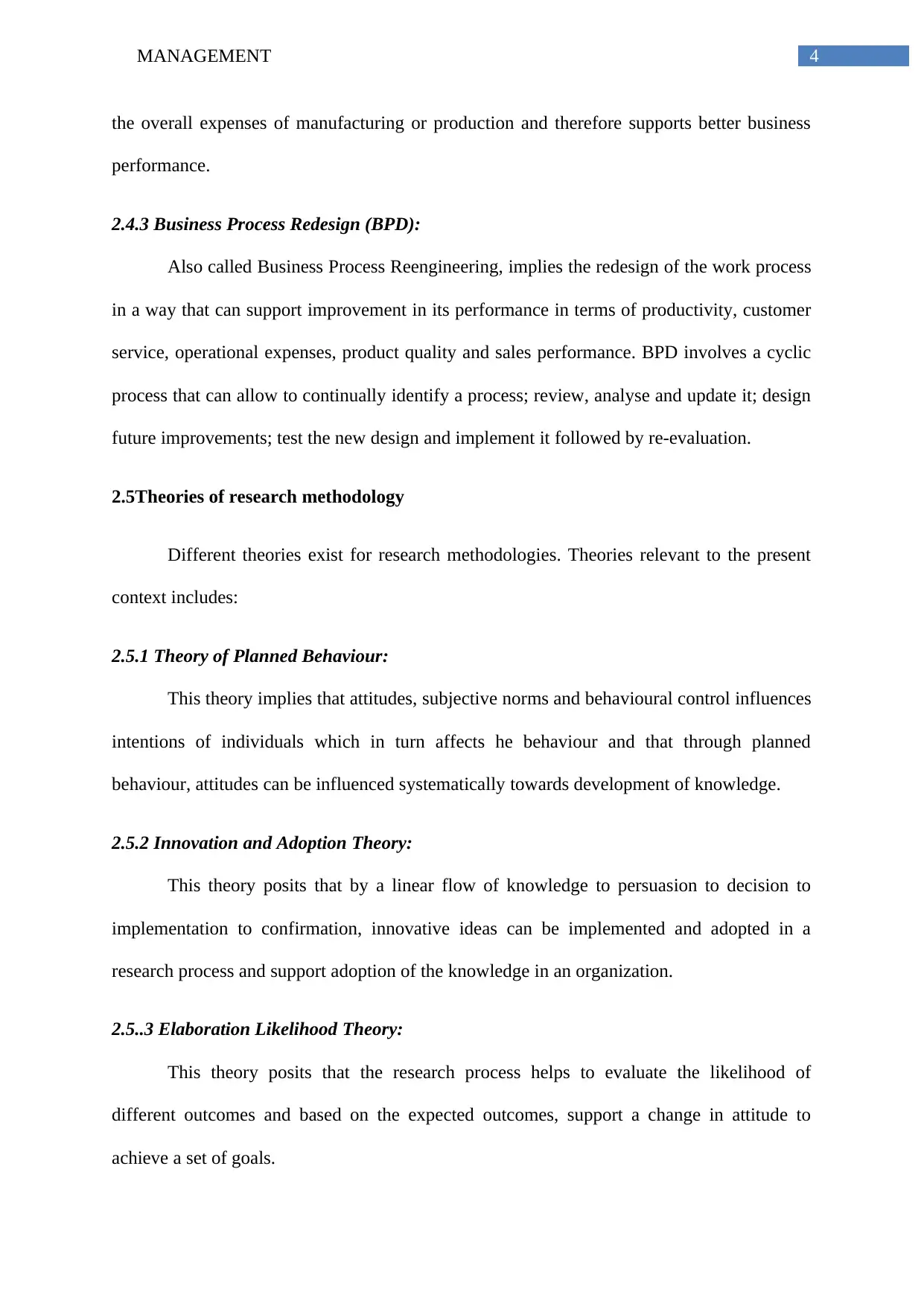
4MANAGEMENT
the overall expenses of manufacturing or production and therefore supports better business
performance.
2.4.3 Business Process Redesign (BPD):
Also called Business Process Reengineering, implies the redesign of the work process
in a way that can support improvement in its performance in terms of productivity, customer
service, operational expenses, product quality and sales performance. BPD involves a cyclic
process that can allow to continually identify a process; review, analyse and update it; design
future improvements; test the new design and implement it followed by re-evaluation.
2.5Theories of research methodology
Different theories exist for research methodologies. Theories relevant to the present
context includes:
2.5.1 Theory of Planned Behaviour:
This theory implies that attitudes, subjective norms and behavioural control influences
intentions of individuals which in turn affects he behaviour and that through planned
behaviour, attitudes can be influenced systematically towards development of knowledge.
2.5.2 Innovation and Adoption Theory:
This theory posits that by a linear flow of knowledge to persuasion to decision to
implementation to confirmation, innovative ideas can be implemented and adopted in a
research process and support adoption of the knowledge in an organization.
2.5..3 Elaboration Likelihood Theory:
This theory posits that the research process helps to evaluate the likelihood of
different outcomes and based on the expected outcomes, support a change in attitude to
achieve a set of goals.
the overall expenses of manufacturing or production and therefore supports better business
performance.
2.4.3 Business Process Redesign (BPD):
Also called Business Process Reengineering, implies the redesign of the work process
in a way that can support improvement in its performance in terms of productivity, customer
service, operational expenses, product quality and sales performance. BPD involves a cyclic
process that can allow to continually identify a process; review, analyse and update it; design
future improvements; test the new design and implement it followed by re-evaluation.
2.5Theories of research methodology
Different theories exist for research methodologies. Theories relevant to the present
context includes:
2.5.1 Theory of Planned Behaviour:
This theory implies that attitudes, subjective norms and behavioural control influences
intentions of individuals which in turn affects he behaviour and that through planned
behaviour, attitudes can be influenced systematically towards development of knowledge.
2.5.2 Innovation and Adoption Theory:
This theory posits that by a linear flow of knowledge to persuasion to decision to
implementation to confirmation, innovative ideas can be implemented and adopted in a
research process and support adoption of the knowledge in an organization.
2.5..3 Elaboration Likelihood Theory:
This theory posits that the research process helps to evaluate the likelihood of
different outcomes and based on the expected outcomes, support a change in attitude to
achieve a set of goals.
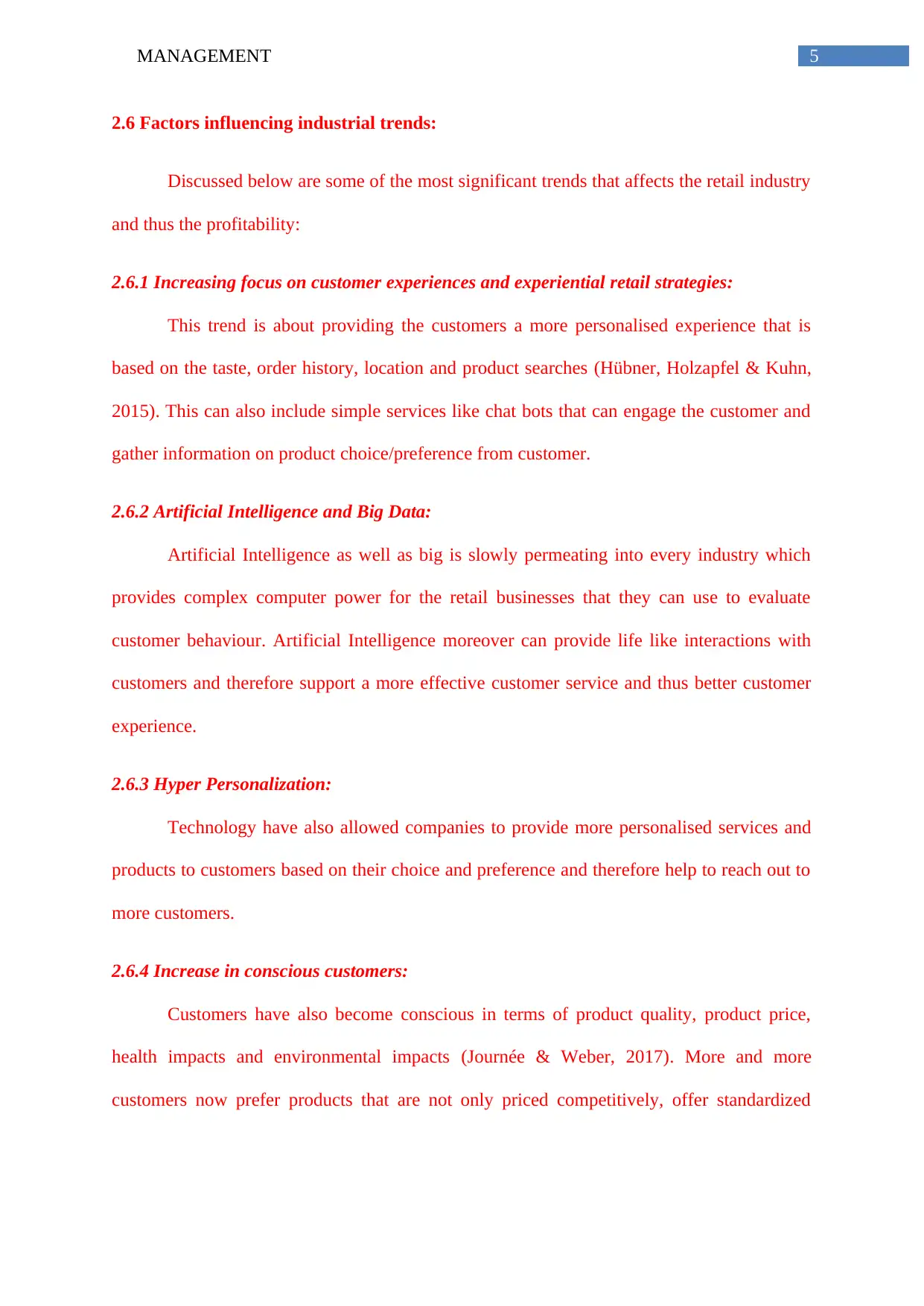
5MANAGEMENT
2.6 Factors influencing industrial trends:
Discussed below are some of the most significant trends that affects the retail industry
and thus the profitability:
2.6.1 Increasing focus on customer experiences and experiential retail strategies:
This trend is about providing the customers a more personalised experience that is
based on the taste, order history, location and product searches (Hübner, Holzapfel & Kuhn,
2015). This can also include simple services like chat bots that can engage the customer and
gather information on product choice/preference from customer.
2.6.2 Artificial Intelligence and Big Data:
Artificial Intelligence as well as big is slowly permeating into every industry which
provides complex computer power for the retail businesses that they can use to evaluate
customer behaviour. Artificial Intelligence moreover can provide life like interactions with
customers and therefore support a more effective customer service and thus better customer
experience.
2.6.3 Hyper Personalization:
Technology have also allowed companies to provide more personalised services and
products to customers based on their choice and preference and therefore help to reach out to
more customers.
2.6.4 Increase in conscious customers:
Customers have also become conscious in terms of product quality, product price,
health impacts and environmental impacts (Journée & Weber, 2017). More and more
customers now prefer products that are not only priced competitively, offer standardized
2.6 Factors influencing industrial trends:
Discussed below are some of the most significant trends that affects the retail industry
and thus the profitability:
2.6.1 Increasing focus on customer experiences and experiential retail strategies:
This trend is about providing the customers a more personalised experience that is
based on the taste, order history, location and product searches (Hübner, Holzapfel & Kuhn,
2015). This can also include simple services like chat bots that can engage the customer and
gather information on product choice/preference from customer.
2.6.2 Artificial Intelligence and Big Data:
Artificial Intelligence as well as big is slowly permeating into every industry which
provides complex computer power for the retail businesses that they can use to evaluate
customer behaviour. Artificial Intelligence moreover can provide life like interactions with
customers and therefore support a more effective customer service and thus better customer
experience.
2.6.3 Hyper Personalization:
Technology have also allowed companies to provide more personalised services and
products to customers based on their choice and preference and therefore help to reach out to
more customers.
2.6.4 Increase in conscious customers:
Customers have also become conscious in terms of product quality, product price,
health impacts and environmental impacts (Journée & Weber, 2017). More and more
customers now prefer products that are not only priced competitively, offer standardized
⊘ This is a preview!⊘
Do you want full access?
Subscribe today to unlock all pages.

Trusted by 1+ million students worldwide
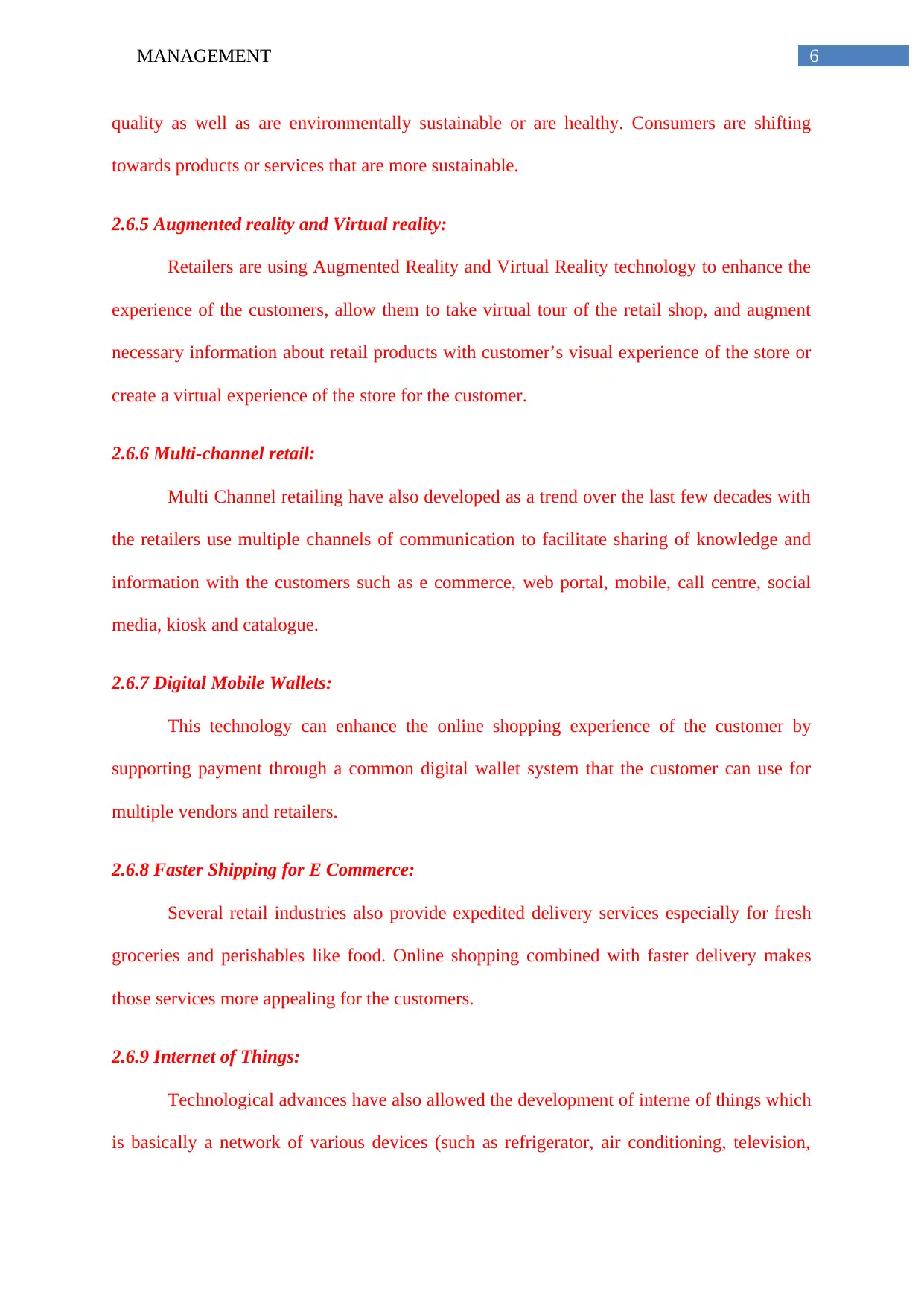
6MANAGEMENT
quality as well as are environmentally sustainable or are healthy. Consumers are shifting
towards products or services that are more sustainable.
2.6.5 Augmented reality and Virtual reality:
Retailers are using Augmented Reality and Virtual Reality technology to enhance the
experience of the customers, allow them to take virtual tour of the retail shop, and augment
necessary information about retail products with customer’s visual experience of the store or
create a virtual experience of the store for the customer.
2.6.6 Multi-channel retail:
Multi Channel retailing have also developed as a trend over the last few decades with
the retailers use multiple channels of communication to facilitate sharing of knowledge and
information with the customers such as e commerce, web portal, mobile, call centre, social
media, kiosk and catalogue.
2.6.7 Digital Mobile Wallets:
This technology can enhance the online shopping experience of the customer by
supporting payment through a common digital wallet system that the customer can use for
multiple vendors and retailers.
2.6.8 Faster Shipping for E Commerce:
Several retail industries also provide expedited delivery services especially for fresh
groceries and perishables like food. Online shopping combined with faster delivery makes
those services more appealing for the customers.
2.6.9 Internet of Things:
Technological advances have also allowed the development of interne of things which
is basically a network of various devices (such as refrigerator, air conditioning, television,
quality as well as are environmentally sustainable or are healthy. Consumers are shifting
towards products or services that are more sustainable.
2.6.5 Augmented reality and Virtual reality:
Retailers are using Augmented Reality and Virtual Reality technology to enhance the
experience of the customers, allow them to take virtual tour of the retail shop, and augment
necessary information about retail products with customer’s visual experience of the store or
create a virtual experience of the store for the customer.
2.6.6 Multi-channel retail:
Multi Channel retailing have also developed as a trend over the last few decades with
the retailers use multiple channels of communication to facilitate sharing of knowledge and
information with the customers such as e commerce, web portal, mobile, call centre, social
media, kiosk and catalogue.
2.6.7 Digital Mobile Wallets:
This technology can enhance the online shopping experience of the customer by
supporting payment through a common digital wallet system that the customer can use for
multiple vendors and retailers.
2.6.8 Faster Shipping for E Commerce:
Several retail industries also provide expedited delivery services especially for fresh
groceries and perishables like food. Online shopping combined with faster delivery makes
those services more appealing for the customers.
2.6.9 Internet of Things:
Technological advances have also allowed the development of interne of things which
is basically a network of various devices (such as refrigerator, air conditioning, television,
Paraphrase This Document
Need a fresh take? Get an instant paraphrase of this document with our AI Paraphraser
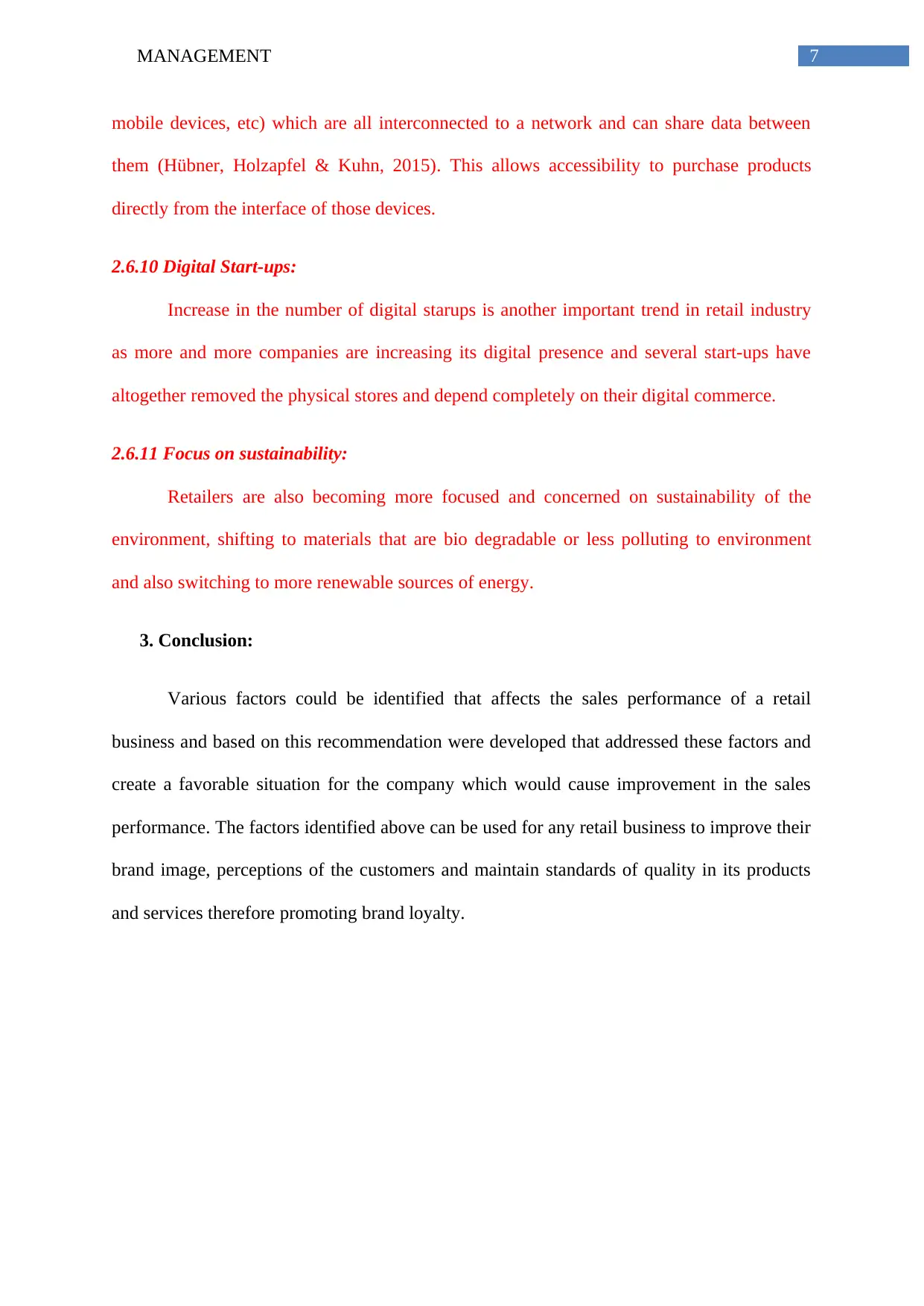
7MANAGEMENT
mobile devices, etc) which are all interconnected to a network and can share data between
them (Hübner, Holzapfel & Kuhn, 2015). This allows accessibility to purchase products
directly from the interface of those devices.
2.6.10 Digital Start-ups:
Increase in the number of digital starups is another important trend in retail industry
as more and more companies are increasing its digital presence and several start-ups have
altogether removed the physical stores and depend completely on their digital commerce.
2.6.11 Focus on sustainability:
Retailers are also becoming more focused and concerned on sustainability of the
environment, shifting to materials that are bio degradable or less polluting to environment
and also switching to more renewable sources of energy.
3. Conclusion:
Various factors could be identified that affects the sales performance of a retail
business and based on this recommendation were developed that addressed these factors and
create a favorable situation for the company which would cause improvement in the sales
performance. The factors identified above can be used for any retail business to improve their
brand image, perceptions of the customers and maintain standards of quality in its products
and services therefore promoting brand loyalty.
mobile devices, etc) which are all interconnected to a network and can share data between
them (Hübner, Holzapfel & Kuhn, 2015). This allows accessibility to purchase products
directly from the interface of those devices.
2.6.10 Digital Start-ups:
Increase in the number of digital starups is another important trend in retail industry
as more and more companies are increasing its digital presence and several start-ups have
altogether removed the physical stores and depend completely on their digital commerce.
2.6.11 Focus on sustainability:
Retailers are also becoming more focused and concerned on sustainability of the
environment, shifting to materials that are bio degradable or less polluting to environment
and also switching to more renewable sources of energy.
3. Conclusion:
Various factors could be identified that affects the sales performance of a retail
business and based on this recommendation were developed that addressed these factors and
create a favorable situation for the company which would cause improvement in the sales
performance. The factors identified above can be used for any retail business to improve their
brand image, perceptions of the customers and maintain standards of quality in its products
and services therefore promoting brand loyalty.
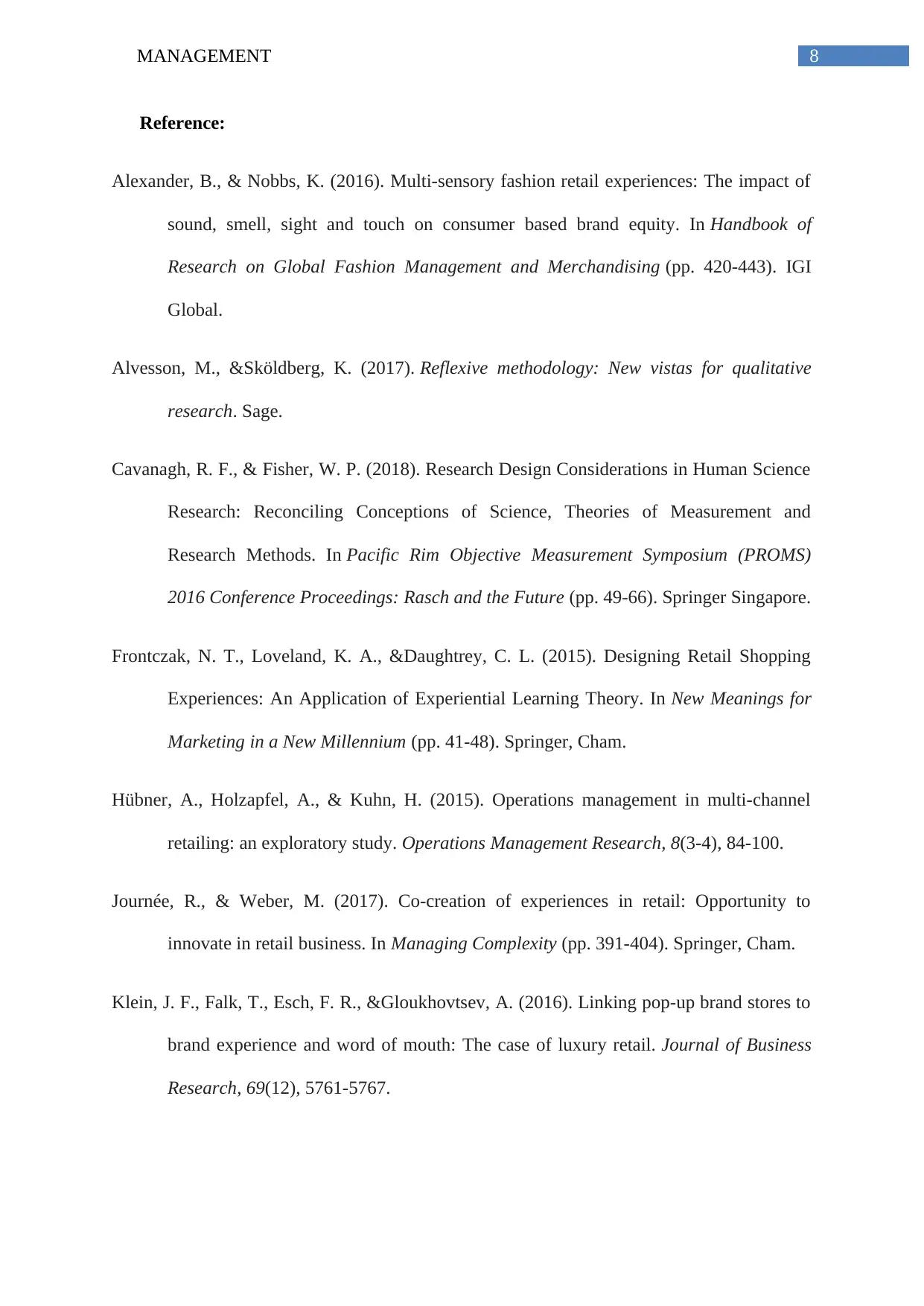
8MANAGEMENT
Reference:
Alexander, B., & Nobbs, K. (2016). Multi-sensory fashion retail experiences: The impact of
sound, smell, sight and touch on consumer based brand equity. In Handbook of
Research on Global Fashion Management and Merchandising (pp. 420-443). IGI
Global.
Alvesson, M., &Sköldberg, K. (2017). Reflexive methodology: New vistas for qualitative
research. Sage.
Cavanagh, R. F., & Fisher, W. P. (2018). Research Design Considerations in Human Science
Research: Reconciling Conceptions of Science, Theories of Measurement and
Research Methods. In Pacific Rim Objective Measurement Symposium (PROMS)
2016 Conference Proceedings: Rasch and the Future (pp. 49-66). Springer Singapore.
Frontczak, N. T., Loveland, K. A., &Daughtrey, C. L. (2015). Designing Retail Shopping
Experiences: An Application of Experiential Learning Theory. In New Meanings for
Marketing in a New Millennium (pp. 41-48). Springer, Cham.
Hübner, A., Holzapfel, A., & Kuhn, H. (2015). Operations management in multi-channel
retailing: an exploratory study. Operations Management Research, 8(3-4), 84-100.
Journée, R., & Weber, M. (2017). Co-creation of experiences in retail: Opportunity to
innovate in retail business. In Managing Complexity (pp. 391-404). Springer, Cham.
Klein, J. F., Falk, T., Esch, F. R., &Gloukhovtsev, A. (2016). Linking pop-up brand stores to
brand experience and word of mouth: The case of luxury retail. Journal of Business
Research, 69(12), 5761-5767.
Reference:
Alexander, B., & Nobbs, K. (2016). Multi-sensory fashion retail experiences: The impact of
sound, smell, sight and touch on consumer based brand equity. In Handbook of
Research on Global Fashion Management and Merchandising (pp. 420-443). IGI
Global.
Alvesson, M., &Sköldberg, K. (2017). Reflexive methodology: New vistas for qualitative
research. Sage.
Cavanagh, R. F., & Fisher, W. P. (2018). Research Design Considerations in Human Science
Research: Reconciling Conceptions of Science, Theories of Measurement and
Research Methods. In Pacific Rim Objective Measurement Symposium (PROMS)
2016 Conference Proceedings: Rasch and the Future (pp. 49-66). Springer Singapore.
Frontczak, N. T., Loveland, K. A., &Daughtrey, C. L. (2015). Designing Retail Shopping
Experiences: An Application of Experiential Learning Theory. In New Meanings for
Marketing in a New Millennium (pp. 41-48). Springer, Cham.
Hübner, A., Holzapfel, A., & Kuhn, H. (2015). Operations management in multi-channel
retailing: an exploratory study. Operations Management Research, 8(3-4), 84-100.
Journée, R., & Weber, M. (2017). Co-creation of experiences in retail: Opportunity to
innovate in retail business. In Managing Complexity (pp. 391-404). Springer, Cham.
Klein, J. F., Falk, T., Esch, F. R., &Gloukhovtsev, A. (2016). Linking pop-up brand stores to
brand experience and word of mouth: The case of luxury retail. Journal of Business
Research, 69(12), 5761-5767.
⊘ This is a preview!⊘
Do you want full access?
Subscribe today to unlock all pages.

Trusted by 1+ million students worldwide
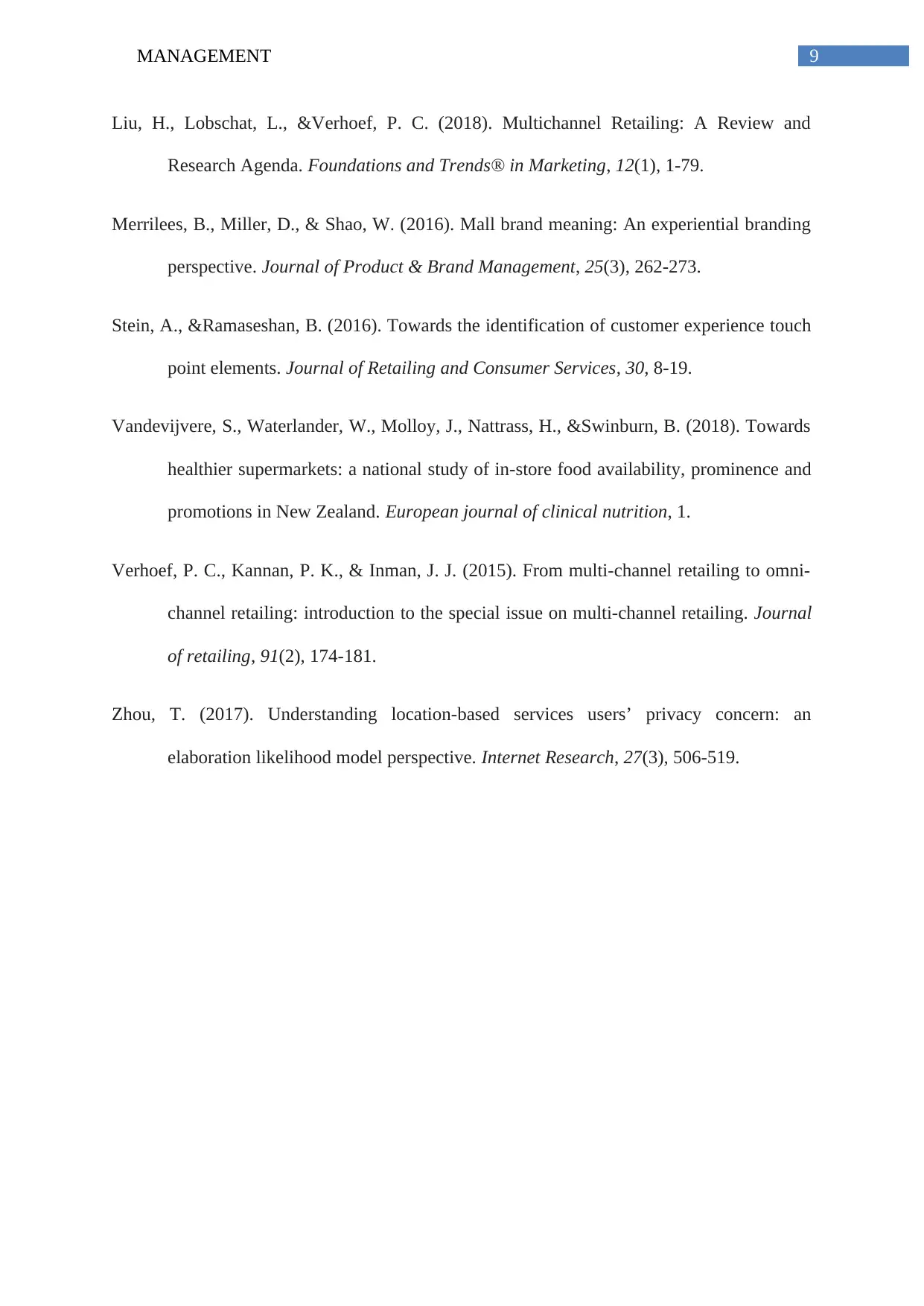
9MANAGEMENT
Liu, H., Lobschat, L., &Verhoef, P. C. (2018). Multichannel Retailing: A Review and
Research Agenda. Foundations and Trends® in Marketing, 12(1), 1-79.
Merrilees, B., Miller, D., & Shao, W. (2016). Mall brand meaning: An experiential branding
perspective. Journal of Product & Brand Management, 25(3), 262-273.
Stein, A., &Ramaseshan, B. (2016). Towards the identification of customer experience touch
point elements. Journal of Retailing and Consumer Services, 30, 8-19.
Vandevijvere, S., Waterlander, W., Molloy, J., Nattrass, H., &Swinburn, B. (2018). Towards
healthier supermarkets: a national study of in-store food availability, prominence and
promotions in New Zealand. European journal of clinical nutrition, 1.
Verhoef, P. C., Kannan, P. K., & Inman, J. J. (2015). From multi-channel retailing to omni-
channel retailing: introduction to the special issue on multi-channel retailing. Journal
of retailing, 91(2), 174-181.
Zhou, T. (2017). Understanding location-based services users’ privacy concern: an
elaboration likelihood model perspective. Internet Research, 27(3), 506-519.
Liu, H., Lobschat, L., &Verhoef, P. C. (2018). Multichannel Retailing: A Review and
Research Agenda. Foundations and Trends® in Marketing, 12(1), 1-79.
Merrilees, B., Miller, D., & Shao, W. (2016). Mall brand meaning: An experiential branding
perspective. Journal of Product & Brand Management, 25(3), 262-273.
Stein, A., &Ramaseshan, B. (2016). Towards the identification of customer experience touch
point elements. Journal of Retailing and Consumer Services, 30, 8-19.
Vandevijvere, S., Waterlander, W., Molloy, J., Nattrass, H., &Swinburn, B. (2018). Towards
healthier supermarkets: a national study of in-store food availability, prominence and
promotions in New Zealand. European journal of clinical nutrition, 1.
Verhoef, P. C., Kannan, P. K., & Inman, J. J. (2015). From multi-channel retailing to omni-
channel retailing: introduction to the special issue on multi-channel retailing. Journal
of retailing, 91(2), 174-181.
Zhou, T. (2017). Understanding location-based services users’ privacy concern: an
elaboration likelihood model perspective. Internet Research, 27(3), 506-519.
1 out of 10
Related Documents
Your All-in-One AI-Powered Toolkit for Academic Success.
+13062052269
info@desklib.com
Available 24*7 on WhatsApp / Email
![[object Object]](/_next/static/media/star-bottom.7253800d.svg)
Unlock your academic potential
Copyright © 2020–2025 A2Z Services. All Rights Reserved. Developed and managed by ZUCOL.





